| LATEST NEWS |
LARGE EDITION PRINTS |
16" EDITION PRINTS |
FOOTBALLER PRINTS |
TRIPLE IMAGE PRINTS |
NAMEPLATE PRINTS |
| PRINT DETAILS & ORDERING | CUSTOMER REVIEWS | THE ARTIST | PRE |
CONTACT DETAILS |
 Click/tap the image to view a larger version
Click/tap the image to view a larger version
LNER A4 CLASS – THE FIFTIES & SIXTIES
The A4s were designed by H. N. Gresley to haul the LNER’s new streamlined service between London and Newcastle which was introduced in autumn 1935 and named ‘Silver Jubilee’ to mark the 25 years of King George V’s reign, with the first four appearing in silver livery to match the train. Further batches were built to work the LNER’s other high-speed train services.
Scale: 5 mm/ft
Paper Size: A3 420 mm x 297 mm (16.5 in x 11.75 in)
Unsigned Print: |
Signed Print: |
||
|
ONLY AVAILABLE TO A UK ADDRESS |
||
No. 60027 Merlin – 1950
When built No. 4486 Merlin was attached to a 1928 streamlined corridor tender, which had previously run with A3s No. 2745 Captain Cuttle and No. 2796 Spearmint. The tender’s top fairing was cut back in December 1937. In December 1941 No. 4486 had its skirting plates removed.
In May 1946 plaques depicting the badge of HMS Merlin, the Royal Naval Air Station at Donibristle, Fife, Scotland, were attached to the cab side, with the works plate being moved inside the cab. The plaques were moved to the boiler sides in June 1948.
It was renumbered No. 27 in May 1946 and after nationalisation 60,000 was added. In July 1950 ‘Magnificent Merlin’ was turned out in standard BR express blue, which is the condition shown.
Built: (Doncaster) March 1937. Withdrawn: September 1965.
No. 60014 Silver Link – 1956
No. 2509 Silver Link was the first A4 to be built for the ‘Silver Jubilee’ service. On 27th September 1935 a publicity trip was organised, hauled by Silver Link and crewed by Driver Arthur Taylor and Fireman Jack Luty. Amongst the records achieved was a peak of 112 mph near Sandy.
It originally appeared in LNER’s silver livery and then went through various liveries changes. The number became No. 14 in June 1946, becoming No. 60014 after nationalisation. The name had been painted on the boiler side but was changed to a cast nameplate in December 1937.
The attached 1935 corridor tender had Timken roller bearings fitted in October 1938. In June 1952 it was painted in BR green with early crest, which is the condition shown.
Built: (Doncaster) September 1935. Withdrawn: December 1962.
No. 60009 Union of South Africa – 1964
No. 4488 was originally named Osprey but with the introduction of the ‘Coronation’ service the locomotives chosen to haul it were named after countries of the British Empire, so in June 1937 No. 4488 was renamed Union of South Africa and had the countries coat of arms added to the cab side. It was also fitted with a South African Railways’ whistle.
It was renumbered No. 9 in February 1947, becoming No. 60009 after nationalisation. A springbok plaque was fitted to the left-hand boiler side in April 1954. In November 1957 a double chimney was fitted; AWS added in February 1960 and a BR speedometer in April 1961.
In November 1963 it was attached to a 1928 corridor tender which, for the 1948 Interchange Trials, had been cut-down at the back to clear the LNWR water cranes at Euston. The livery at this time was BR green with later totem, which is the condition shown.
Built: (Doncaster) April 1937. Withdrawn: June 1966. It has been preserved.
The above information is supplied with the print.
Prints are sent rolled in individual postal tubes.

Ordering Online: You will be taken to a secure page where
payments
are taken through PayPal.
Please note: you don't need, or have to create,
a PayPal
account
to
pay by credit card. See here